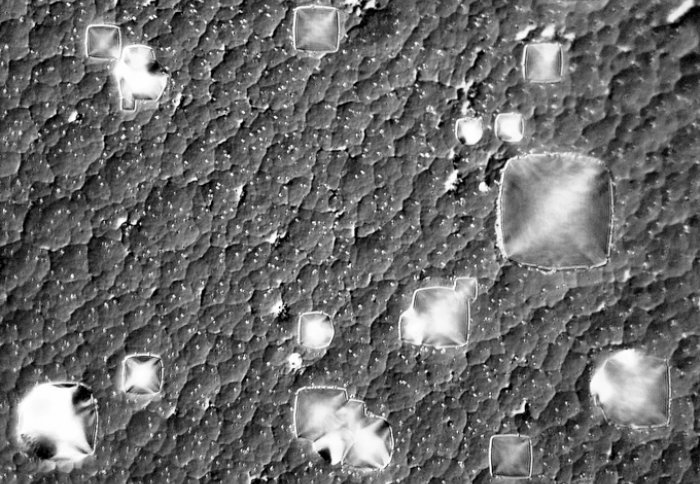Miniature landscape of solar cells bags physicist top photo prize

'Pyramids in a desert' - or the surface of a silicon solar cell
An Imperial physicist won second prize in the Innovation category of EPSRC's science photography competition for his image of a solar cell close up.
Dr Diego Alonso-Alvarez took the photo using his iPhone 4s looking down an optical microscope. It shows the surface of a silicon solar cell - the units that make up solar panels - at only the width of a human hair.
Entering this completion was a way of sharing those unique images and moments with other people, showing the most beautiful part of our daily life.
– Dr Diego Alonso-Alvarez
He titled the picture 'Pyramids in a Desert' due to its resemblance to Egyptian pyramids and sand dunes seen from directly above.
Dr Alonso-Alvarez said: “When doing science, we are so focused on the actual research that we forget that, very often, what we experience and see is amazing and only for our eyes.
"Entering this completion was a way of sharing those unique images and moments with other people, showing the most beautiful part of our daily life.”
The competition seeks to showcase the work funded by the Engineering and Physical Sciences Research Council (EPSRC).
Dr Alonso-Alvarez studies the nanoscopic design of silicon solar cells in order to make them more effective at generating both electricty and heat.
He took this image while checking different surface treatments and etching recipes to control the size and shape of the silicon textures on the cell's surface.

Actual pyramids in an actual desert. Image: NASA
Collaborators on the project from the University of Glasgow also won a prize in the competition for their image of a solar cell from a different angle. The teams hope to combine their findings in the near future.
Congratulating the winners and entrants, Professor Tom Rodden, EPSRC’s Deputy Chief Executive, said: “The quality of entries into our competition demonstrates that EPSRC-funded researchers are keen to show the world how beautiful and interesting science and engineering can be. I’d like to thank everyone who entered; judging was really difficult.
“These stunning images are a great way to engage the public with the research they fund, and inspire everyone to take an interest in science and engineering.”
Article supporters
Article text (excluding photos or graphics) © Imperial College London.
Photos and graphics subject to third party copyright used with permission or © Imperial College London.
Reporter
Hayley Dunning
Communications Division